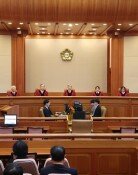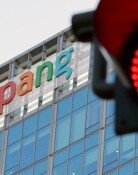The Korean Renaissance

Korean paintings are changing. Flowery, colored paintings are not anomalies any more. Elements from pop art such as cartoon characters and animated film characters are appearing on canvases, and a variety of installation artworks are on display.
Young artists in their 20s and 30s are leading the way.
The Ilmin Museum of Art in Sejong-no, Jongno-gu, Seoul, selected paintings from 38-year-old Korean painter Kim Eun-jin for its first exhibition of the New Year. Her unique Asian paintings will be on display starting from January 20 in an exhibit titled: Bad Icons.
After painting the base of her pictures with powder colors that are flowery and plain, she twists the essence of various religious icons such as Jesus Christ, the Virgin Mary, and the pope with a unique point of view, using mixed images of them. In her paintings, the floweriness that can be found in western paintings and the plainness that can be found in Korean paintings are mixed.
Sometimes, western painting artists borrow Korean painting themes. Sunni Kim (37) who will hold a solo exhibition on the first floor of the Ilmin Museum of Art simultaneously with Kim Eun-jin, is a case in point. She is a western painter, but she has borrowed images of Asian landscape paintings. In an exhibition titled The Perfect Landscape, no traces of her favorite motifs, such as the 10 symbols of longevity or people who are hunting can be found. Only landscapes such as mountains and rocks fill her pictures. Both exhibitions will continue until February 19. (For more information, call 02-2020-2055.)
Han Eun-sun (37), whose paintings will be on display from February 8 to March 5 in the Gallery Sang in Insa-dong, Jongno-gu, Seoul, uses ingredients that are common to traditional Korean painting, but pursues a world that is quite different from it. Han paints by saturating a water-soaked jangji (traditional Korean paper) with India ink or dye and creates patterns by repeatedly dropping the water on the paper. By using the simple processes of blotting, spreading and drying, Han expresses the world of abstraction. (For more information, contact 02-730-0030.)
Yim Taek (34) is a painter who turns one-dimensional traditional landscape paintings into three-dimensional artworks. His eighth solo exhibition titled: Relocated Landscapes: A Travel Journal, is now being held at the Insa Art Space in Gwanhun dong, Jongno-gu, Seoul, and consists of installation artworks that depict landscapes and that are created in hanji (another type of traditional Korean paper). Miniature people are placed in the landscapes that consist of rocks, pine trees, pavilions and overpasses. His works show that installation artworks are no longer the exclusive possession of western artists and reflect the multi-pronged expansion of Korean painting. The exhibition will continue until January 27. (For more information, contact 02-760-4722.)
When mentioning the expansion of Korean painting, one cannot fail to mention animation. In the past, only a few painters experimentally drew moving paintings in India ink by combining traditional paintings in India ink with high-tech animation. However, a few years ago, this trend started to spread rapidly among young artists who majored in Korean painting. Kim Yoon-ok, a curator at the Kumho Museum of Art in Seoul, organized a playing-museum of paper, pens and ink where these various changes in Korean painting could be introduced. There was a time when it was said that the survival of Korean painting itself was in question, Kim says. But that is now a thing of the past. The various experiments that young Korean artists have been conducting are making me anticipate a Korean painting renaissance.
Mun-Myung Huh angelhuh@donga.com







